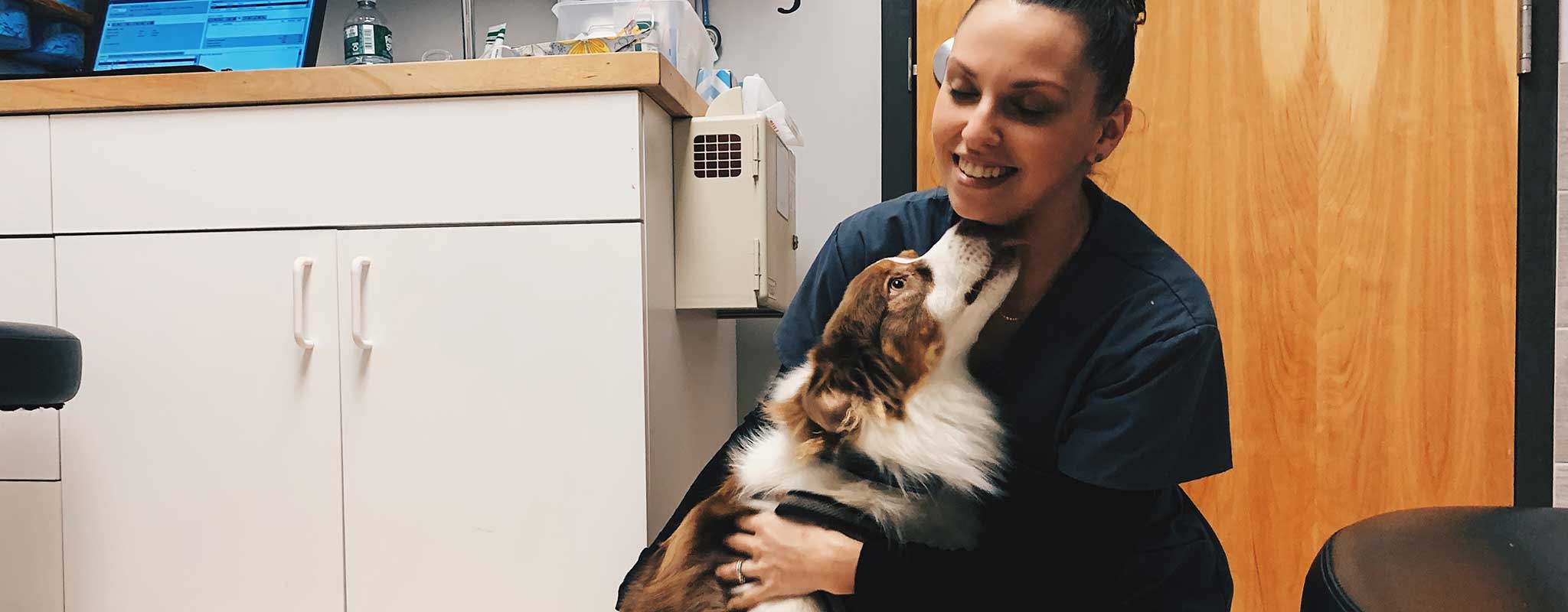Keeping Pets Healthy for Life
Vaccinations and Preventive Health Care
Recommendations for Cats Recommendations for Dogs
Because we care for all the pets that come to us, we want to give them the best possible chance for a long and healthy life. We do this by creating a plan for disease prevention, which can keep them healthy and strong for a lifetime. At Vestal Veterinary Hospital and Emergency Clinic, we design this plan based on the type of pet, your needs, and lifestyle.
The following are examples of our general recommendations for cats and dogs—vaccination plans, parasite control, and dental care—with some explanation of common diseases and symptoms. Remember that these are general recommendations and no two animals are exactly alike.
Preventive Health Care Recommendations for Cats
Respiratory disease is easily passed from one cat to another by droplets in the air from coughing or sneezing. Kittens can die from the disease, especially if they get pneumonia.
Cats with respiratory disease have watery or sticky discharge from the nose and eyes, nose and mouth sores, inflamed eyes, and fever. Most respiratory diseases are caused by one of two viruses—feline viral rhinotracheitis or feline calicivirus. Rhinotracheitis tends to be more severe and can cause abortions in pregnant cats. Panleukopenia, or feline distemper, is an intestinal disease, causing vomiting and diarrhea.
Vaccination recommendations:
- Begin vaccinations at about 8 weeks of age
- Revaccinate every 4 weeks until 16 weeks of age
- Revaccination should be one year after the initial doses are administered, then every three years to maintain adequate protection
All warm-blooded animals (dogs, cats, livestock, and wildlife) can become infected with rabies virus. Because rabies is also a threat to humans, many states, including New York, require vaccination of all dogs and cats. Even indoor cats can be exposed to rabies, often by wildlife (especially bats) entering the house.
Rabies is a virus that attacks nerve tissue. The disease develops slowly over 10 days to several months. Infected animals may withdraw and avoid contact with people and animals. Others become unnaturally aggressive and may attack. Death always occurs once a rabies-infected animal shows signs of disease.
In North America, most rabies exists in wildlife, especially raccoons, skunks, foxes, and bats. Rabies is spread by bite wounds and exposure to the saliva of infected animals. Therefore, an unvaccinated cat involved in a fight with a wild animal, or with wounds from an unknown animal encounter, should be suspected for rabies exposure. When rabies is diagnosed, any exposed, unvaccinated animals must be quarantined for six months or euthanized (humanely destroyed). In contrast, an exposed, vaccinated animal is given a booster vaccine and is then considered safe from infection.
If humans are infected, they can be vaccinated successfully in the early stages of the disease. Treatment, however, is unpleasant and costly.
Vaccination recommendations:
- First vaccination is given at 3 months of age or older
- Revaccination is done one year later, then repeated at one or three year intervals, depending upon the vaccine administered.
Feline Leukemia Virus (FeLV) and Feline Immunodeficiency Virus are two common viruses in cats. Infection can be from mother to kitten (usually just with FeLV) or from exposure to another infected cat (both FeLV and FIV). All new additions to a household should be tested for these two important diseases. Both viruses affect cats by interfering with the immune system, leaving it unable to fight off other infections. While some cats can successfully fight off an infection with one of these viruses, most cats that become infected will eventually die from a virus-related disease.
Test recommendation:
- Test all new cats; kittens retest 1-2 months later if tested prior to 9 weeks of age
Feline Leukemia vaccination recommendation:
The vaccine for FeLV is well-tested and effective, and we routinely vaccinate all kittens. In adult cats we assess the risk of infection and help the owner decide on a case-by-case basis whether revaccination is needed based on lifestyle.
- 2 initial vaccinations given 2 to 4 weeks apart. We then recommend revaccination at one year and then as often as annually dependent on life-style risk factors.
FIP vaccination recommendation:
Feline infectious peritonitis (FIP) is a frustrating disease for researchers—recent work suggests it is caused by a mutation of a virus common to the systems of many, if not most, cats. As such, vaccination is not likely to make a significant difference in the incidence of the disease and is no longer part of the preventive health care recommendations. We do not carry this vaccine nor recommend its use.
Visit our Wellness, and Oral Pet Health pages for more tips on caring for your feline pets.
Preventive Health Care Recommendations For Dogs
Canine Distemper Virus causes diarrhea, fever, respiratory disease, seizures, muscular twitches, and a discharge from the eyes and nose. While it is no longer a common disease, it is still seen in unvaccinated animals, particularly from shelters, and in puppies.
Canine Hepatitis is a disease common to young and unvaccinated animals. The virus attacks organs throughout the dog’s body producing fever, respiratory disease, enlarged lymph nodes, and abdominal pain.
Parainfluenza Virus causes respiratory disease. It usually is not life threatening unless pneumonia develops. It is one of the organisms implicated in "Kennel Cough."
Parvo Virus causes severe intestinal problems in dogs. Infected individuals have bloody diarrhea, vomiting, and become quite depressed and dehydrated quickly.
Vaccination recommendations:
- Begin vaccinations at 6–8 weeks of age
- Continue vaccinations every 3 weeks until 16–17 weeks of age
- Revaccination 1 year later, then every 3 years to maintain adequate protection
Lyme disease is a tick-borne bacterial disease caused by the organism Borrelia burgdorferi. A recent study demonstrated its presence in nearly 50% of ticks examined in New York State. Clinical signs include pain and lameness, fever, lethargy, loss of appetite, and depression.
Vaccination recommendations:
This has become a major health concern for our pets and we recommend vaccination of all dogs.
- Two puppy doses at approximately 12 and 15 weeks of age
- Annual revaccination to maintain adequate levels of immunity
Leptospirosis is a bacterium most commonly affecting the kidneys, although it can affect many of the major organs. It is introduced to the environment in the urine of livestock and wildlife, especially raccoons (who will urinate on your lawn, and then your dog will eat the grass). This organism is also transmissible to humans.
Vaccination recommendations:
- Two puppy doses at approximately 12 and 15 weeks of age
- Annual revaccination to maintain adequate levels of immunity
All warm-blooded animals (dogs, cats, livestock, and wildlife) can become infected with rabies virus. Because rabies is also a threat to humans, many states, including New York, require vaccination of all dogs and cats. Even indoor animals can be exposed to rabies, often by wildlife (especially bats) entering the house.

Rabies is a virus that attacks nerve tissue. The disease develops slowly over 10 days to several months. Infected animals may withdraw and avoid contact with people and other animals. Others become unnaturally aggressive and may attack. Death always occurs once a rabies-infected animal shows signs of disease.
In North America, most rabies exists in wildlife, especially raccoons, skunks, foxes, and bats. Rabies is spread by bite wounds and exposure to the saliva of infected animals. Therefore, an unvaccinated dog involved in a fight with a wild animal, or with wounds from an unknown animal encounter should be suspected for rabies exposure. When rabies is diagnosed, by law, any exposed, unvaccinated animals must be quarantined for six months or euthanized. In contrast, an exposed, vaccinated animal is given a booster vaccine and is then considered safe from infection.
If humans are infected, they can be vaccinated successfully in early stages of the disease. Treatment, however, is unpleasant and costly.
Vaccination Recommendations:
- First vaccination is given at 3 months of age or older
- Revaccinate in 1 year, and then revaccinate every 2-3 years, or annually in some outdoor dogs or those at high risk of exposure to the disease
Bordetella is the principal organism involved with Kennel Cough. Transmission usually occurs when dogs are housed together in close proximity such as in a boarding kennel, grooming parlor, or at a dog show. It causes a dry, hacking cough that can persist for days or even weeks. We primarily recommend this vaccine for "at-risk" dogs that are to be boarded or that are groomed on a regular basis.
Vaccination recommendations:
- First dose given at 3 weeks of age or older, at least 1 week before boarding, then annually as indicated
Influenza is another respiratory disease of dogs. It is similar in signs to kennel cough initially, but can progress to pneumonia and even death in severe cases. There are two strains of this virus, the initial H3N8 strain and the more recent H3N2 strain. Both strains are now present in settings where dogs are housed in close contact (boarding kennels, groomers, dog shows, etc).
We do not consider Influenza to be a "core" vaccine, but the incidence of the disease is concerning enough that immunization for both strains is considered prudent for all "at-risk" pets - that is, pets falling into the previously mentioned lifestyle situations.
Vaccination recommendations:
- Two initial doses given 2-3 weeks apart for at risk dogs and annual revaccination.
Visit our Wellness, and Oral Pet Health pages for more tips on caring for your canine pets.




